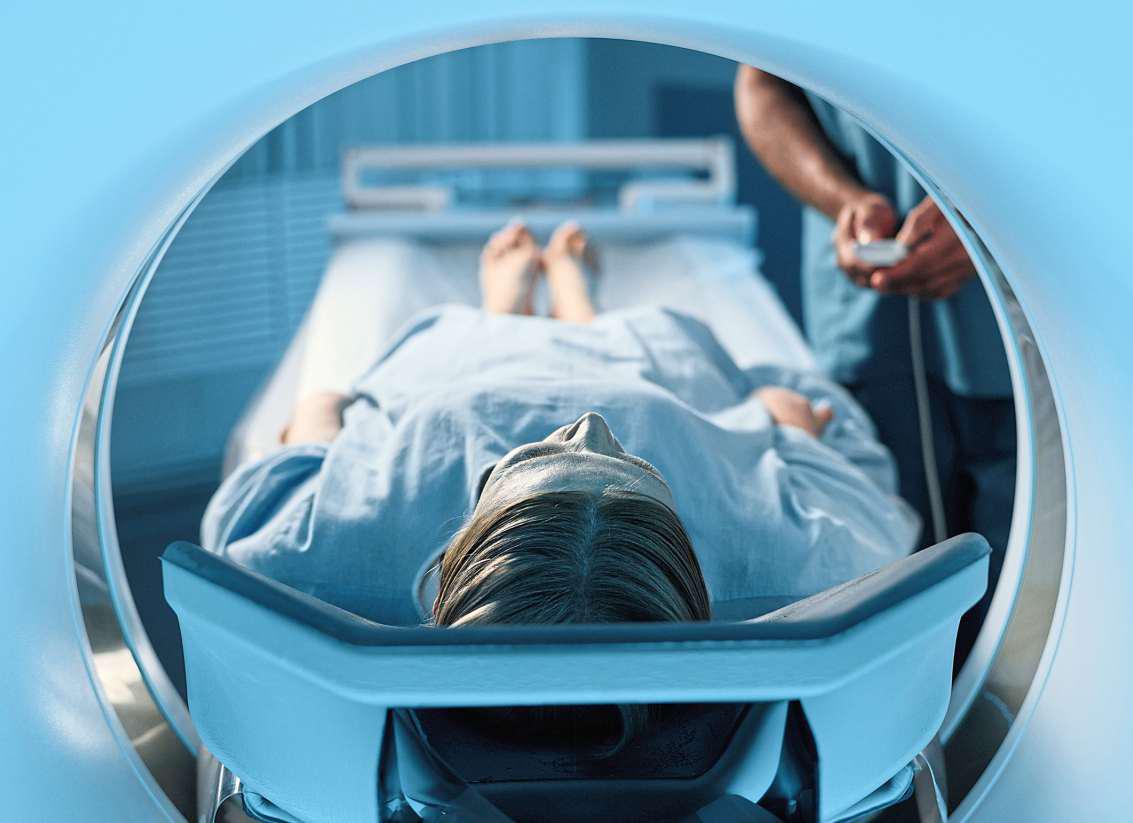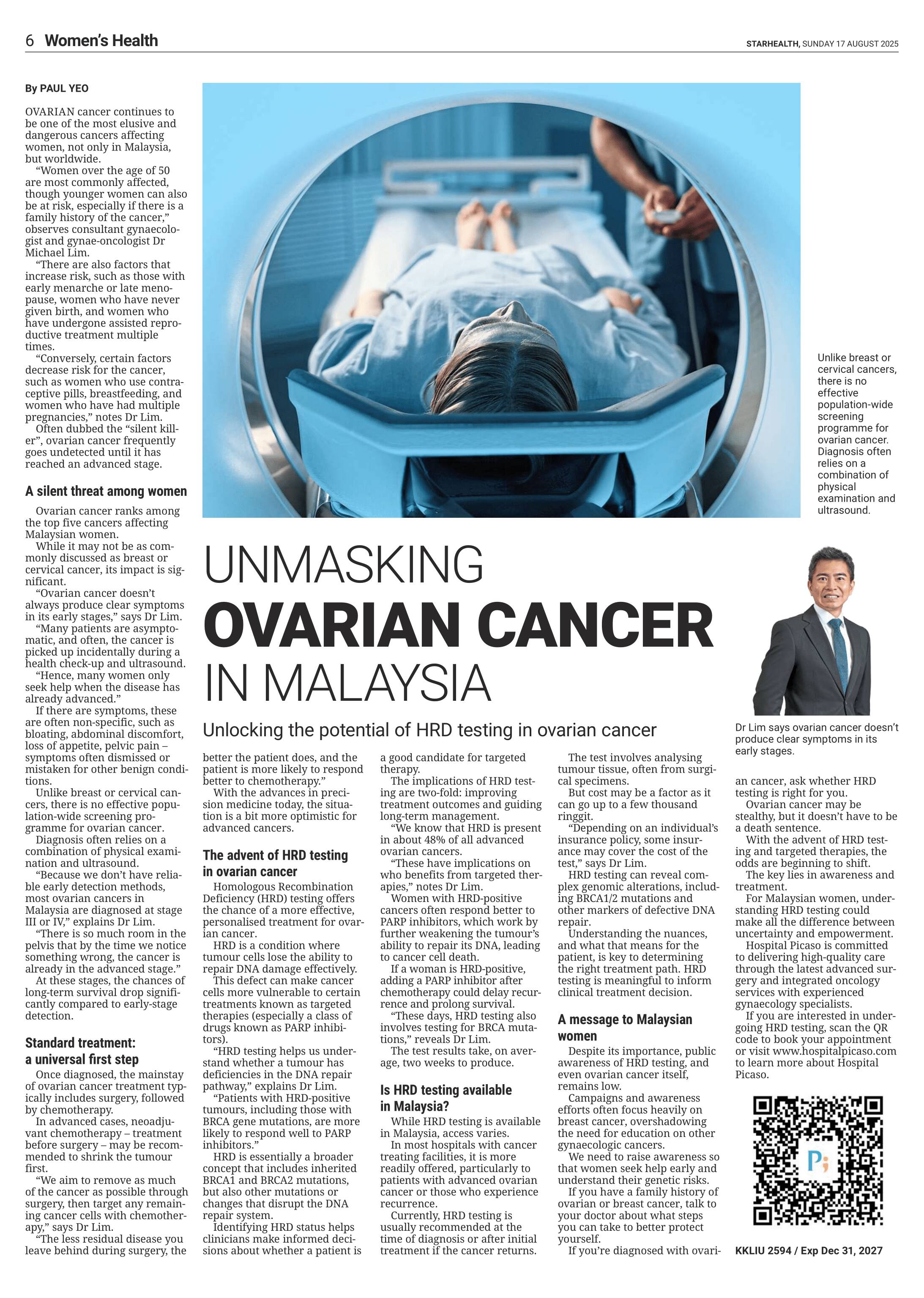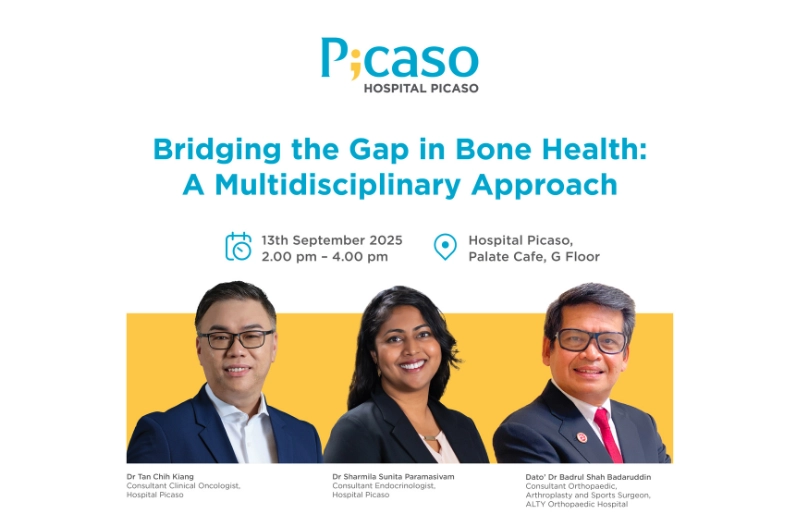UNMASKING OVARIAN CANCER IN MALAYSIA
August 17, 2025

OVARIAN cancer continues to be one of the most elusive and dangerous cancers affecting women, not only in Malaysia, but worldwide.
"Women over the age of 50 are most commonly affected, though younger women can also be at risk, especially if there is a family history of the cancer," observes consultant gynaecologist and gynae-oncologist Dr Michael Lim.
"There are also factors that increase risk, such as those with early menarche or late menopause, women who have never given birth, and women who have undergone assisted reproductive treatment multiple times.
"Conversely, certain factors decrease risk for the cancer, such as women who use contraceptive pills, breastfeeding, and women who have had multiple pregnancies," notes Dr Lim.
Often dubbed the "silent killer", ovarian cancer frequently goes undetected until it has reached an advanced stage.
A silent threat among women
Ovarian cancer ranks among the top five cancers affecting Malaysian women.
While it may not be as commonly discussed as breast or cervical cancer, its impact is significant.
"Ovarian cancer doesn't always produce clear symptoms in its early stages," says Dr Lim.
"Many patients are asymptomatic, and often, the cancer is picked up incidentally during a health check-up and ultrasound.
"Hence, many women only seek help when the disease has already advanced."
If there are symptoms, these are often non-specific, such as bloating, abdominal discomfort, loss of appetite, pelvic pain – symptoms often dismissed or mistaken for other benign conditions.
Unlike breast or cervical cancers, there is no effective population-wide screening programme for ovarian cancer.
Diagnosis often relies on a combination of physical examination and ultrasound.
"Because we don't have reliable early detection methods, most ovarian cancers in Malaysia are diagnosed at stage III or IV," explains Dr Lim.
"There is so much room in the pelvis that by the time we notice something wrong, the cancer is already in the advanced stage."
At these stages, the chances of long-term survival drop significantly compared to early-stage detection.
Standard treatment: a universal first step
Once diagnosed, the mainstay of ovarian cancer treatment typically includes surgery, followed by chemotherapy.
In advanced cases, neoadjuvant chemotherapy – treatment before surgery – may be recommended to shrink the tumour first.
"We aim to remove as much of the cancer as possible through surgery, then target any remaining cancer cells with chemotherapy," says Dr Lim.
"The less residual disease you leave behind during surgery, the better the patient does, and the patient is more likely to respond better to chemotherapy."
With the advances in precision medicine today, the situation is a bit more optimistic for advanced cancers.
The advent of HRD testing in ovarian cancer
Homologous Recombination Deficiency (HRD) testing offers the chance of a more effective, personalised treatment for ovarian cancer.
HRD is a condition where tumour cells lose the ability to repair DNA damage effectively.
This defect can make cancer cells more vulnerable to certain treatments known as targeted therapies (especially a class of drugs known as PARP inhibitors).
"HRD testing helps us understand whether a tumour has deficiencies in the DNA repair pathway," explains Dr Lim.
"Patients with HRD-positive tumours, including those with BRCA gene mutations, are more likely to respond well to PARP inhibitors."
HRD is essentially a broader concept that includes inherited BRCA1 and BRCA2 mutations, but also other mutations or changes that disrupt the DNA repair system.
Identifying HRD status helps clinicians make informed decisions about whether a patient is a good candidate for targeted therapy.
The implications of HRD testing are two-fold: improving treatment outcomes and guiding long-term management.
"We know that HRD is present in about 48% of all advanced ovarian cancers.
"These have implications on who benefits from targeted therapies," notes Dr Lim.
Women with HRD-positive cancers often respond better to PARP inhibitors, which work by further weakening the tumour's ability to repair its DNA, leading to cancer cell death.
If a woman is HRD-positive, adding a PARP inhibitor after chemotherapy could delay recurrence and prolong survival.
"These days, HRD testing also involves testing for BRCA mutations," reveals Dr Lim.
The test results take, on average, two weeks to produce.
Is HRD testing available in Malaysia?
While HRD testing is available in Malaysia, access varies.
In most hospitals with cancer treating facilities, it is more readily offered, particularly to patients with advanced ovarian cancer or those who experience recurrence.
Currently, HRD testing is usually recommended at the time of diagnosis or after initial treatment if the cancer returns.
The test involves analysing tumour tissue, often from surgical specimens.
But cost may be a factor as it can go up to a few thousand ringgit.
"Depending on an individual's insurance policy, some insurance may cover the cost of the test," says Dr Lim.
HRD testing can reveal complex genomic alterations, including BRCA1/2 mutations and other markers of defective DNA repair.
Understanding the nuances, and what that means for the patient, is key to determining the right treatment path. HRD testing is meaningful to inform clinical treatment decision.
A message to Malaysian women
Despite its importance, public awareness of HRD testing, and even ovarian cancer itself, remains low.
Campaigns and awareness efforts often focus heavily on breast cancer, overshadowing the need for education on other gynaecologic cancers.
We need to raise awareness so that women seek help early and understand their genetic risks.
If you have a family history of ovarian or breast cancer, talk to your doctor about what steps you can take to better protect yourself.
If you're diagnosed with ovarian cancer, ask whether HRD testing is right for you.
Ovarian cancer may be stealthy, but it doesn't have to be a death sentence.
With the advent of HRD testing and targeted therapies, the odds are beginning to shift.
The key lies in awareness and treatment.
For Malaysian women, understanding HRD testing could make all the difference between uncertainty and empowerment.
Hospital Picaso is committed to delivering high-quality care through the latest advanced surgery and integrated oncology services with experienced gynaecology specialists.

If you are interested in undergoing HRD testing, scan the QR code to book your appointment or visit www.hospitalpicaso.com to learn more about Hospital Picaso.
KKLIU 2594 / Exp Dec 31, 2027
Source
Unmasking Ovarian Cancer in Malaysia (The Star, 17 August 2025).
Reference











